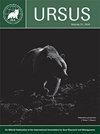demetR:一个用于收获管理的贝叶斯种群模拟web应用程序
IF 0.8
4区 生物学
Q4 ZOOLOGY
引用次数: 2
摘要
摘要:大型食肉动物种群的管理是一项重要的保护挑战,需要平衡其文化、经济和生态价值与人类与野生动物冲突的潜在风险。收获可以为种群管理提供一种有效的工具,但很难确定适当的收获配额或评估其他保护措施的后果。我们介绍了网络应用程序“demetR”(“动态环境建模和估算R轨迹”,可在https://pop-eco.shinyapps.io/demetR/上找到)来评估收获情景和其他保护政策对棕熊(Ursus arctos)和美国黑熊(U. americanus)种群的影响。我们开发了一个贝叶斯种群轨迹模型来模拟棕熊和黑熊的种群,以响应用户自定义的人口参数和收获。模型模拟使用固定或随机人口统计参数进行,允许信息和非信息先验。我们提供了总体布局的概述,以及模型输入和输出的描述。然后,我们提供了使用确定性和随机方法模拟不同收获水平的熊种群的例子。对不同的管理场景进行计算机模拟提供了一种经济有效的方法,可以在应用之前对实践进行测试,并且对决策有价值。这个模型也可以应用于其他具有类似生活史特征的物种。未来的发展将为用户提供更大的输入灵活性和适应其他大型食肉动物的特定种群结构。管理决策可能代价高昂,并带来长期的生态和经济后果。在结构化决策和适应性管理的背景下,我们在这里展示的模型可以提高做出这些决策所需的信息的质量和数量。本文章由计算机程序翻译,如有差异,请以英文原文为准。
demetR: a Bayesian population simulation web-application for harvest management
Abstract: Management of large carnivore populations represents an important challenge in conservation, requiring balancing their cultural, economic, and ecological value with potential risks of human–wildlife conflicts. Harvest can provide an effective tool for managing populations, but it can be difficult to define appropriate harvest quotas or assess the consequences of other conservation measures. We introduce the web-application ‘demetR’ (“Dynamic Environment for Modeling and Estimating Trajectories in R,” available at https://pop-eco.shinyapps.io/demetR/) to evaluate the effects of harvest scenarios and other conservation policies on brown bear (Ursus arctos) and American black bear (U. americanus) populations. We developed a Bayesian population trajectory model to simulate brown bear and black bear populations in response to user-defined demographic parameters and harvest. Model simulations are performed using fixed or stochastic demographic parameters, allowing for informative and non-informative priors. We provide an overview of the general layout, along with descriptions of model inputs and outputs. We then provide examples of bear populations simulated using deterministic and stochastic approaches with varying levels of harvest. Performing computer simulations of different management scenarios offers an economical and efficient way to test practices before their application, and can be valuable for decision-making. This model can also be applied to other species with similar life-history traits. Future developments will provide users with greater input flexibility and adaptations to specific population structures of other large carnivores. Management decisions can be costly, with long-lasting ecological and economic consequences. Models such as the one we present here, in the context of structured decision-making and adaptive management, can improve the quality and quantity of information needed to make these decisions.
求助全文
通过发布文献求助,成功后即可免费获取论文全文。
去求助
来源期刊

Ursus
生物-动物学
CiteScore
2.00
自引率
15.40%
发文量
12
审稿时长
>12 weeks
期刊介绍:
Ursus includes a variety of articles on all aspects of bear management and research worldwide. Original manuscripts are welcome. In addition to manuscripts reporting original research, submissions may be based on thoughtful review and synthesis of previously-reported information, innovative philosophies and opinions, and public policy or legal aspects of wildlife conservation. Notes of general interest are also welcome. Invited manuscripts will be clearly identified, but will still be subject to peer review. All manuscripts must be in English. All manuscripts are peer-reviewed, and subject to rigorous editorial standards.
 求助内容:
求助内容: 应助结果提醒方式:
应助结果提醒方式:


